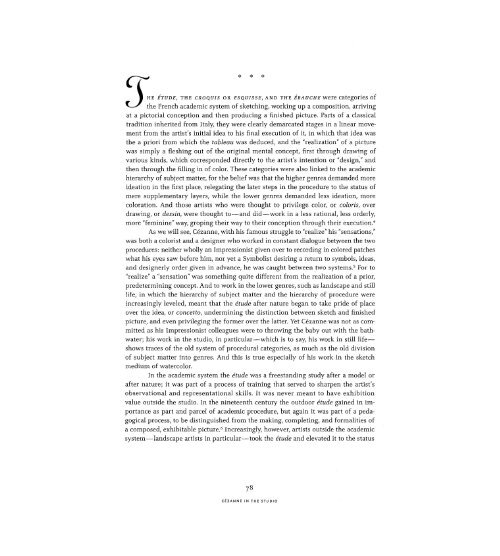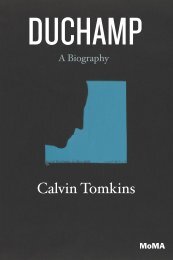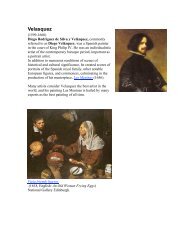Still Life in Watercolors
qbj8dgc
qbj8dgc
- No tags were found...
Create successful ePaper yourself
Turn your PDF publications into a flip-book with our unique Google optimized e-Paper software.
jHE ÉTUDE, THE CROQUIS OR ESQUISSE, AND THE ÉBA UCHE Were Categories of<br />
the French academic system of sketch<strong>in</strong>g, work<strong>in</strong>g up a composition, arriv<strong>in</strong>g<br />
at a pictorial conception and then produc<strong>in</strong>g a f<strong>in</strong>ished picture. Parts of a classical<br />
tradition <strong>in</strong>herited from Italy, they were clearly demarcated stages <strong>in</strong> a l<strong>in</strong>ear movement<br />
from the artist's <strong>in</strong>itial idea to his f<strong>in</strong>al execution of it, <strong>in</strong> which that idea was<br />
the a priori from which the tableau was deduced, and the "realization" of a picture<br />
was simply a flesh<strong>in</strong>g out of the orig<strong>in</strong>al mental concept, first through draw<strong>in</strong>g of<br />
various k<strong>in</strong>ds, which corresponded directly to the artist's <strong>in</strong>tention or "design," and<br />
then through the fill<strong>in</strong>g <strong>in</strong> of color. These categories were also l<strong>in</strong>ked to the academic<br />
hierarchy of subject matter, for the belief was that the higher genres demanded more<br />
ideation <strong>in</strong> the first place, relegat<strong>in</strong>g the later steps <strong>in</strong> the procedure to the status of<br />
mere supplementary layers, while the lower genres demanded less ideation, more<br />
coloration. And those artists who were thought to privilege color, or coloris, over<br />
draw<strong>in</strong>g, or dess<strong>in</strong>, were thought to—and did—work <strong>in</strong> a less rational, less orderly,<br />
more "fem<strong>in</strong><strong>in</strong>e" way, grop<strong>in</strong>g their way to their conception through their execution. 4<br />
As we will see, Cézanne, with his famous struggle to "realize" his "sensations,"<br />
was both a colorist and a designer who worked <strong>in</strong> constant dialogue between the two<br />
procedures: neither wholly an Impressionist given over to record<strong>in</strong>g <strong>in</strong> colored patches<br />
what his eyes saw before him, nor yet a Symbolist desir<strong>in</strong>g a return to symbols, ideas,<br />
and designerly order given <strong>in</strong> advance, he was caught between two systems. 5 For to<br />
"realize" a "sensation" was someth<strong>in</strong>g quite different from the realization of a prior,<br />
predeterm<strong>in</strong><strong>in</strong>g concept. And to work <strong>in</strong> the lower genres, such as landscape and still<br />
life, <strong>in</strong> which the hierarchy of subject matter and the hierarchy of procedure were<br />
<strong>in</strong>creas<strong>in</strong>gly leveled, meant that the étude after nature began to take pride of place<br />
over the idea, or concetto, underm<strong>in</strong><strong>in</strong>g the dist<strong>in</strong>ction between sketch and f<strong>in</strong>ished<br />
picture, and even privileg<strong>in</strong>g the former over the latter. Yet Cézanne was not as committed<br />
as his Impressionist colleagues were to throw<strong>in</strong>g the baby out with the bathwater;<br />
his work <strong>in</strong> the studio, <strong>in</strong> particular—which is to say, his work <strong>in</strong> still life—<br />
shows traces of the old system of procedural categories, as much as the old division<br />
of subject matter <strong>in</strong>to genres. And this is true especially of his work <strong>in</strong> the sketch<br />
medium of watercolor.<br />
In the academic system the étude was a freestand<strong>in</strong>g study after a model or<br />
after nature; it was part of a process of tra<strong>in</strong><strong>in</strong>g that served to sharpen the artist's<br />
observational and representational skills. It was never meant to have exhibition<br />
value outside the studio. In the n<strong>in</strong>eteenth century the outdoor étude ga<strong>in</strong>ed <strong>in</strong> importance<br />
as part and parcel of academic procedure, but aga<strong>in</strong> it was part of a pedagogical<br />
process, to be dist<strong>in</strong>guished from the mak<strong>in</strong>g, complet<strong>in</strong>g, and formalities of<br />
a composed, exhibitable picture. 6 Increas<strong>in</strong>gly, however, artists outside the academic<br />
system—landscape artists <strong>in</strong> particular—took the étude and elevated it to the status<br />
78<br />
CÉZANNE IN THE STUDIO




